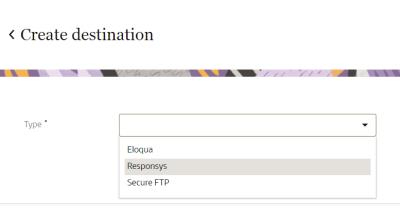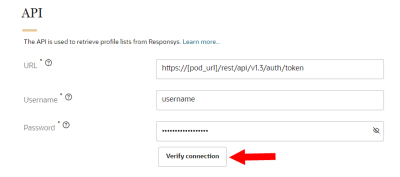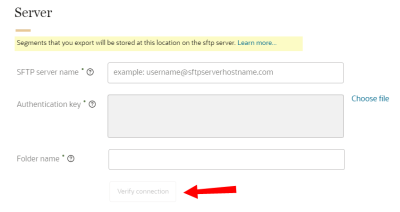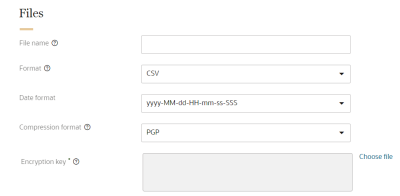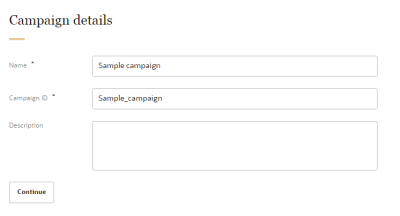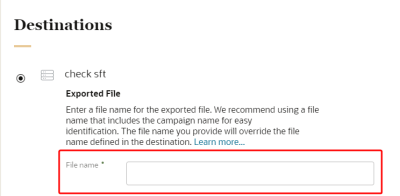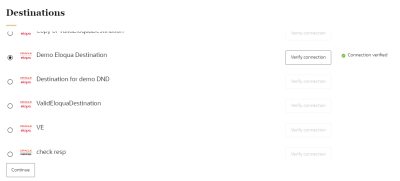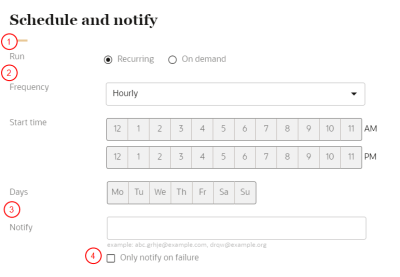Setting up the export of data to Oracle Responsys
The first step in integrating with Oracle Responsys is setting up the export of data to so that you can seamlessly send segments you create in Oracle Unity to Responsys for use in campaigns and programs. This involves creating a Responsys destination and then the segment delivery that will export the data to Responsys.
Create the Responsys destination
Yyou will need to create a Responsys destination to configure where the data will be exported to.
To create the Responsys destination:
-
Click the Oracle icon
 in the bottom-right corner to open the navigation menu.
in the bottom-right corner to open the navigation menu.
- Select Destinations.
- In the top-right corner, click Create destination.
Step 1: Define destination details
The job details section allows you to define the type of destination and how it will display in Oracle Unity.
Enter the information for the destination.
- Type: Use the drop-down list to select Responsys .
- Name: Enter a name. The name must be 1 or more characters, up to a maximum of 50. Use only letters (a–z and A–Z), numbers (0–9), underscores (_), hyphens (-), and spaces. The first character cannot be a space.
-
Destination ID: The unique system identifier that is auto-populated from the destination name you enter. You can't change this value after you create the destination.
- Description: Enter a description. This field is optional, but it is highly recommended to add descriptions for any entity created. This helps all other users get additional context when using and navigating Oracle Unity. The description can have a maximum of 512 characters with no restrictions on characters used. You can use characters from all languages supported in the language settings.
Step 2: Configure API settings
Enter the information for the Responsys API.
- URL: Enter the login endpoint for the system that hosts your Oracle Responsys account in this format: https://[pod_URL]/rest/api/v1.3/auth/token. To get the pod URL for your account, refer to the Responsys REST API authentication endpoint URLs topic from the Responsys Developer Help Center. Learn more about Refreshing Tokens from the REST API for Oracle Responsys Marketing Cloud Service Help Center.
- Username: Enter the username of an Oracle Responsys API user that Oracle Unity can use for the API request. An Oracle Responsys API user is a user that has the Web Services API roles, as described in the Role Descriptions and Access Controls topic in the Oracle Responsys Help Center. The API user you choose does not need to be a dedicated API user.
- Password: Enter the password of the Oracle Responsys API user.
Note: For Global Routing customers, your unique global routing endpoint details are available in the Responsys interface. In Responsys, select Account > Global settings > Account configuration and look for the endpoint in the WS End Point field.
Important: Make sure that the Responsys API user allows password authentication. If the user is set up for only certificate authentication, a connection to the API will not be possible. Contact your Responsys Account Administrator to update these authentication options.
Once you enter all the details, click Verify connection to ensure that Oracle Unity can access the API.
If there are connection issues, it could be for one of the following reasons:
- An incorrect username and password for the API user.
- The password for the API user is expired.
- The user authentication options for the API user only allow for certificate authentication. Contact your Responsys Account Administrator to update the authentication options to allow for password authentication or to obtain a different API user who can authenticate using a password.
Step 3: Configure server settings
Important: When defining the authentication settings, make sure that one of the approved algorithms below is used to access the destination. If one of these algorithms is not used, Oracle Unity will not be able to successfully connect to the destination.
| Algorithm type | Algorithm |
|---|---|
| Cipher | aes256-ctr |
| Cipher | aes192-ctr |
| Cipher | aes128-ctr |
Configure the server settings for the segment delivery.
- SFTP server name: Enter the hostname for your organization's SFTP server. This field requires a user name and host name, formatted as username@sftpserverhostname.com.
- Authentication key: Select the file that has the authentication key needed to access the SFTP server. Oracle Unity will process the file and display the authentication key.
- Oracle Unity only supports private authentication keys in RSA format. You can't upload a public authentication keys.
- To create an RSA authentication key, learn how to Generate SSH Keys in PEM Format to Connect to a Public or On-Premises sFTP Server from the Using the FTP Adapter with Oracle Integration Help Center.
- Folder name: Enter the path name to the folder on the SFTP server where Oracle Unity should export files to.
Once you enter all the details, click Verify connection to ensure that Oracle Unity can access the server.
If there are connection issues, it could be for one of the following reasons:
- An incorrect SFTP server name.
- An incorrect authentication key.
- An incorrect Folder name.
If you still encounter connection issues, contact your IT administrator for further investigation.
Step 4: Configure Profile list and Match key
You will need to select the Profile list and Match key for the segment delivery job.
-
The Audience created from this segment delivery job will be attached to the selected profile list in Responsys.
-
The match key is used to match the data in the segment to the profiles in Responsys.
Select the Profile list and Match key.
-
Profile list: Use the drop-down list to select the profile list or search by the list name.
-
Match key: Select the match key that will be used to match the exported data to profiles.
-
CUSTOMER_ID_
-
EMAIL_ADDRESS_
-
MOBILE_NUMBER_
You can select the following match keys:
Warning: When creating the segment that will be exported, make sure that one of the personalization attributes uses an alias that exactly matches the match key selected. If this alias is not included for one of the personalization attributes, the segment will not be exported successfully to Responsys.
Step 5: Configure file settings
The files details section defines the format of the destination files.
- File name: Enter the file name and extension to use for the exported files. A timestamp and file number will be added as a suffix identifying when the file was created. The timestamp will be in the format yyyy-MM-dd-HH-mm-ss-SSS. You can use characters from all languages supported in the language settings.
- Format: The format of the exported file must be in CSV format. Fields in the exported file will be separated by commas.
- Date format: The date format of the exported file must be yyyy-MM-dd-hh-mm-ss-SSS. A timestamp with this format will be added as a suffix to the exported file.
- Compression format: The compression format must be gzip .
Example: If you enter the file name as Export_file_01, a timestamp will be added as a suffix and the file will be named Export_file_01_2021-05-12-12-56-12-926_0.csv. The timestamp is 2021-05-12-12-56-12-926. The "0" indicates it is the first exported file with the same timestamp.
Step 5: Save and publish the new destination
When finished defining the destination, scroll to the top of the page and click Save or Save and close.
Once you create the destination, you will need to publish the changes.
After creating and publishing the destination, you can create the segment delivery.
Create the segment delivery
You will need to create the segment delivery that will export the segment data to Oracle Responsys.
To create the segment delivery:
-
Click the Oracle icon
 in the bottom-right corner to open the navigation menu.
in the bottom-right corner to open the navigation menu.
- Select Segment Deliveries.
- In the top-right corner, click Create segment delivery.
The Create segment delivery page is displayed.
Step 1: Define segment delivery details
The segment delivery details section allows you to define how the segment delivery will display in Oracle Unity.
To define the segment delivery details:
- Enter the details for the segment delivery.
- Name: Enter a name. The name must be 1 or more characters, up to a maximum of 30. Use only letters (a–z and A–Z), numbers (0–9), underscores (_), hyphens (-), and spaces. The first character cannot be a space.
-
Campaign ID: The unique system identifier for your campaign. You can't change this value after you create the campaign.
- If the campaign name uses English characters, the Campaign ID field is auto-populated from the campaign name you enter. You can change this value before the campaign is created.
- If the campaign name uses characters from another language supported in the language settings, the Campaign ID field will be left blank. You will need to enter a name using English characters.
- Description: Enter a description. This field is optional, but it is highly recommended to add descriptions for any entity created. This helps all other users get additional context when using and navigating Oracle Unity. The description can have a maximum of 512 characters with no restrictions on characters used. You can use characters from all languages supported in the language settings.
- Click Continue.
Step 2: Select destination
You will select the Responsys destination you created earlier.
To select the destination:
- Select the Responsys destination.
- Review and confirm the Profile list and Match key selected for the destination are correct.
- Enter a custom file name for the exported file.
- We recommend using a file name that includes the segment delivery name for easy identification.
- The file name you provide will override the file name defined in the destination.
- A timestamp will be added to the custom file name you provide in the following format: yyyy-MM-dd-HH-mm-ss-SSS. For example, entering the file name segment_delivery_job_sale will generate the following file name in the destination when it runs: segment_delivery_job_sale_2020-05-13-08-04-13-354_0.csv.
- Click Verify connection to ensure that Oracle Unity can access the destination.
- After verifying the connection, click Continue.
Note: The Profile list and Match key will be pulled from the destination when the segment delivery is first created and can't be changed after the segment delivery is created and saved. If you need to change the Profile list or Match key for a segment delivery, you will need to create a new segment delivery and select a destination with the correct Profile list/Match key.
Example: You create a destination with the file name sftpfile.csv and use it for the following segment deliveries: Repeat shopper segment, Summer sale segment, and Homeowner segment. When setting up the segment delivery jobs, you can create the following unique file names for each one: sftpfile_repeat_shopper, sftpfile_summer_sale, and sftpfile_homeowner. This allows you to quickly determine which segment was exported in each file.
Step 3: Select segment
You will select the segment you want to export to Responsys.
To select a segment:
- Search by the segment name and click
 . Then, select the segment.
. Then, select the segment. - Review the details for the segment and click Continue.
Step 4: Schedule and notify
You will need to configure the schedule and notification settings for the segment delivery.
To schedule the segment delivery and define the notification settings:
- Configure the schedule for the segment delivery:
- Click Recurring to automatically run the segment delivery job on a regular schedule.
- Click On demand to run the segment delivery job as needed.
- If the segment delivery job is recurring, select the Frequency, Start time, and Days it will run.
- In the field for Notify, enter the email addresses of people to be notified when the segment delivery job runs. Separate multiple emails with a comma.
- If you only want a notification if the segment delivery job fails, click the checkbox Only notify on failure.
Step 5: Save and publish the segment delivery
After saving the segment delivery you will need to publish the changes before it can run.
To save and publish the segment delivery:
- Scroll to the top of the page and click Save or Save and close.
- Follow the steps for Publishing changes.
